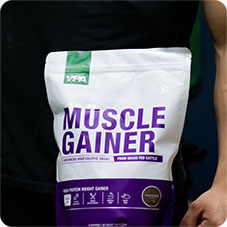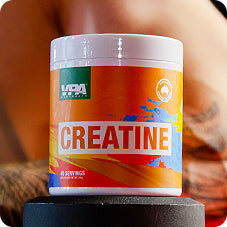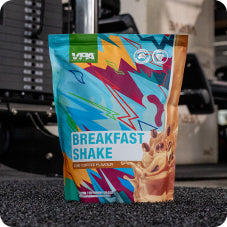Your Cart is Empty
Why endurance athletes should be strength training
May 17, 2020 3 min read

Strength training has an important part to play in the program of all endurance athletes. While it can be hard to fit into your training program, it should be considered a necessary component of training for athletes who want to run faster and remain injury free. Incorporating strength work into your training has benefits for health, general athleticism and sports performance. This blog will explain why endurance athletes should be strength training and what benefits to their health and performance they can expect.
The benefits of strength training for endurance athletes
Strength training can benefit endurance athletes in three areas.
- Health – Strength training prevents injury by addressing muscle imbalances created during the repetitive movement of endurance sports.
- Athleticism – All athletes need to have sufficient strength, stability, power and mobility to train for the specifics of their sport. Strength training contributes to all of these.
- Performance – Strength training leads to increased power (rate of force production) and improves running and cycling economy; many studies have shown increased performance, and none show a decrease.
Strength training for masters athletes
For masters athletes, strength training is even more important. As we age, we lose muscle mass faster than we lose cardiovascular fitness. This leads to long term health issues as well as performance decline. You will slow the inevitable decline in performance by including strength work in your program.
Strength training improves endurance performance
Studies have consistently shown endurance performance benefits in response to strength training. If you convincing, here are a couple of study results.
Blagrove (2017) found in a systematic review that strength training improved running economy, time trial performance and anaerobic speed, concluding that “the addition of two to three ST [strength training] sessions per week, which include a variety of ST modalities are likely to provide benefits to the performance of middle- and long-distance runners.”
Ronnestad (2011) found that combining heavy strength training and regular endurance training increased cyclists’ mean power output production during a final 5-min all-out sprint after 3 h of submaximal cycling by 7%. Sounds like a race winning strategy to me
How does strength training improve endurance performance?
So now that we understand it does work, lets look at the possible mechanisms behind the benefits of strength training to endurance performance.
- Delayed use of less efficient type II (fast twitch) muscle fibres – With strength training, your Type I (slow twitch, endurance) muscle fibres become stronger so are working at a lower relative intensity during sub-maximal exercise. Stronger fibres mean than less muscle mass is used in each contraction, increasing the amount of rest each fibre gets. This means the Type I fibres can work for longer before becoming exhausted and forcing type II fibres to step in.
- Conversion of muscle fibre types – Some studies have shown increased proportion of Type IIA fibres. Type IIA are more efficient and fatigue more slowly so are more suited to endurance performance.
- Rate of force development – Increases in neural activation (how your brain activates muscle fibres) improve economy in both runners and cyclists (especially for low cadence work).
- Muscle-tendon stiffness – Elastic storage and return of energy by tendons contributes a large component of the energy needed for running. Stiffer tendons are more effective and reduce the overall energy demands, even at relatively slow speeds.
Now that you understand why strength training should be an integral part any endurance program, my next blog will talk about how to incorporate it into your training.
Nutrition for running your best half marathon or marathon
Supplements for runners and endurance athletes

Chris Taylor
Chris is a duathlete, cyclist, and runner. He has represented Australia at the ITU Age Group Long Distance Duathlon World Championships and won the Brutal Extreme Duathlon in 2018. Chris holds multiple coaching accreditations and coaches online and in person. Chris lives in Holmfirth, Yorkshire in the UK with his wife, two girls and whippet. He believes no ride is complete without a cafe stop.
Also in Training

Routine and Discipline – The Backbone of Fitness
March 01, 2024 2 min read
Discover the importance of routine and discipline in fitness. Explore calisthenics for beginners, running cadence, and more. Read now on VPA Training Blogs.
Read More
Calisthenics for Beginners
February 21, 2024 5 min read
Learn how to start your calisthenics journey as a beginner. Discover the advantages, tips to avoid injuries, and how to incorporate calisthenics into your daily routine. Boost your mental health and understand the importance of rest and recovery. Read more on VPA's blog.
Read More
Running Cadence: The Key to Efficient Running and Injury Prevention
February 16, 2024 4 min read
Learn how running cadence can improve your running efficiency, prevent injuries, and increase speed. Find out how to determine your current cadence and ways to improve it.
Read More Recent Articles
- Routine and Discipline – The Backbone of Fitness
- Calisthenics for Beginners
- Running Cadence: The Key to Efficient Running and Injury Prevention
- Pilates: A Guide for Beginners
- What is DOMS? A guide to relieving sore muscles.
- Flexibility Development for Athletes: Key Strategies and Benefits
- Active Recovery for Rest Days
- Fitness & Hormones: What does cortisol do?
- Underrated Health Metrics You Shouldn't Ignore
- The Ultimate Guide to Tricep Workouts: Build Strong and Toned Arms


















